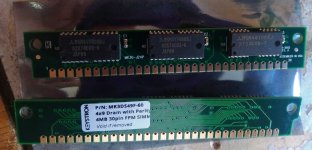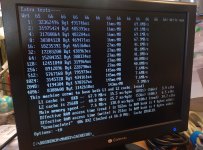Anonymous Coward
Veteran Member
Maybe it's just my imagination, but is the cache memory really 35ns? That seems awfully slow for a 486. I think the slowest I've ever seen is 25ns.
From the first photo in this thread of the mainboard? Well thats how this board came I honestly couldnt tell you otherwise.Maybe it's just my imagination, but is the cache memory really 35ns? That seems awfully slow for a 486. I think the slowest I've ever seen is 25ns.
could you run CACHECHK and let us know what the access times are like? I'd be curious to know what timings that memory was setup forFrom the first photo in this thread of the mainboard? Well thats how this board came I honestly couldnt tell you otherwise.
This? : https://www.philscomputerlab.com/dos-benchmark-pack.htmlcould you run CACHECHK and let us know what the access times are like? I'd be curious to know what timings that memory was setup for
Im willng to try, Gotta a source for those 15ns cache chips?I checked the part numbers for those cache chips. They really are 35ns.
MS62256A - Mosel Vitelic Corporation Datasheet PDF VIEW DOWNLOAD - DATASHEETBANK.COM
MS62256A Datasheet : 32K x 8 High Speed CMOS Static RAM, MS62256A PDF VIEW Download Mosel Vitelic Corporation , MS62256A 1 page Datasheet PDF, Pinouts, Data Sheet, Equivalent, Schematic, Cross reference, Obsolete, Circuitswww.datasheetbank.com
For a 33MHz 486, that's pretty rough. Normally at 33MHz, nothing slower than 20ns is used.
It would be unfortunate to alter the original condition of this board, but I would think you could get a pretty significant speed boost by swapping in some 15ns parts and adjusting BIOS timings accordingly.


Wait, you only bought 2 SIMMs? The 486 having a 32bit data bus requires they be installed in matching sets of 4...... Ok lets get to the updates... Im not happy.
So the RAM came in: View attachment 1273412
No matter what combination I try it wont work. I learned that this machine wont boot with any less than four of the ram sockets populated with 1MB simms which need to be installed with the first simm closest to the CACHE chips.
So if those wont work what do I do? I cant return them. Thats money lost I guess. Any ideas?
On to cachechk. For some reason if I boot into DOS and run it it freezes. The program with start. In the bottom left it will have XMS present then the next line down VCPI present.. then it locks. So I need to bypass my startup files/use a boot disk then run Cachechk -v memory managers causing an issue? I have no idea.
HEre is the output: View attachment 1273419
Just found this thread and seems my nic isnt so cut and dry. https://forum.vcfed.org/index.php?posts/1366657/Yes but specifically also in the XUB config
Were both floppy's formatted on the same drive? If not, that could be an issue.I have had a nightmare of a time setting this machine up. Conflict after conflict. I will make an update but first I have something that might be a serious problem. Why is it when I directory a floppy disk. Remove it, and insert a new disk and do DIR, it returns the same results as the first disk even though its not? I have to goto the B: for a second, then back to the A: and then it will read the new disk. What is going on here? This seems very ungood.
No I dont have that option. Ill look into it.Do you have a DRIVPARM line in config.sys? If so, what does it contain. If not try putting one in.
Were both floppy's formatted on the same drive? If not, that could be an issue.
There is an assumption that 1.2M drives are configured to generate a 'disk changed' signal (on pin 34 of the cable) when the floppy is changed. If that signal is not being generated, DOS (and it would be versions 3.0 and later) assume that the disk has not been changed, and will use a cached copy of the directory.Why is it when I directory a floppy disk. Remove it, and insert a new disk and do DIR, it returns the same results as the first disk even though its not? I have to goto the B: for a second, then back to the A: and then it will read the new disk. What is going on here? This seems very ungood.
BTW. In at least early versions of DOS, a CTRL-C key combination would force a fresh read of the floppy (like what we had to do in the CP/M OS).I have to goto the B: for a second, then back to the A: and then it will read the new disk.
Yes as other's have said this is definitely a problem with the disk changed line. You can add a DRIVPARM directive to force DOS to ignore the signal as suggested, but that is treating the symptom not the cause.I have had a nightmare of a time setting this machine up. Conflict after conflict. I will make an update but first I have something that might be a serious problem. Why is it when I directory a floppy disk. Remove it, and insert a new disk and do DIR, it returns the same results as the first disk even though its not? I have to goto the B: for a second, then back to the A: and then it will read the new disk. What is going on here? This seems very ungood.
